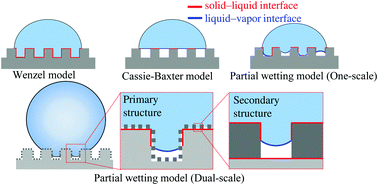当前位置:
X-MOL 学术
›
Soft Matter
›
论文详情
Our official English website, www.x-mol.net, welcomes your
feedback! (Note: you will need to create a separate account there.)
Intermediate wetting state at nano/microstructured surfaces
Soft Matter ( IF 2.9 ) Pub Date : 2020/02/19 , DOI: 10.1039/c9sm02513h Gyoko Nagayama 1, 2, 3, 4 , Dejian Zhang 1, 2, 3, 4
Soft Matter ( IF 2.9 ) Pub Date : 2020/02/19 , DOI: 10.1039/c9sm02513h Gyoko Nagayama 1, 2, 3, 4 , Dejian Zhang 1, 2, 3, 4
Affiliation

|
A general partial wetting model to describe an intermediate wetting state is proposed in this study to explain the deviations between the experimental results and classical theoretical wetting models for hydrophobic surfaces. We derived a theoretical partial wetting model for the static intermediate wetting state based on the thermodynamic energy minimization method. The contact angle based on the partial wetting model is a function of structural parameters and effective wetting ratio f, which agrees with the classical Wenzel and Cassie–Baxter models at f = 1 and 0, respectively. Si samples including porous surfaces, patterned surfaces and hierarchical nano/microstructured surfaces were prepared experimentally, having the same chemical composition but different physical morphology. We found that the experimental water contact angles deviate significantly from the classical Wenzel and Cassie–Baxter models but show good agreement with the proposed partial wetting model.
中文翻译:

纳米/微结构表面的中间润湿状态
本研究提出了一种描述中间润湿状态的通用局部润湿模型,以解释疏水性表面的实验结果与经典理论润湿模型之间的偏差。基于热力学能量最小化方法,我们推导了静态中间润湿状态的理论部分润湿模型。基于局部润湿模型的接触角是结构参数和有效润湿比f的函数,与经典的Wenzel和Cassie–Baxter模型在f处一致= 1和0。通过实验制备了包括多孔表面,图案化表面和分层的纳米/微结构化表面的Si样品,它们具有相同的化学组成但具有不同的物理形态。我们发现实验水接触角与经典的Wenzel和Cassie-Baxter模型有很大的偏离,但与提出的部分润湿模型显示出很好的一致性。
更新日期:2020-04-08
中文翻译:

纳米/微结构表面的中间润湿状态
本研究提出了一种描述中间润湿状态的通用局部润湿模型,以解释疏水性表面的实验结果与经典理论润湿模型之间的偏差。基于热力学能量最小化方法,我们推导了静态中间润湿状态的理论部分润湿模型。基于局部润湿模型的接触角是结构参数和有效润湿比f的函数,与经典的Wenzel和Cassie–Baxter模型在f处一致= 1和0。通过实验制备了包括多孔表面,图案化表面和分层的纳米/微结构化表面的Si样品,它们具有相同的化学组成但具有不同的物理形态。我们发现实验水接触角与经典的Wenzel和Cassie-Baxter模型有很大的偏离,但与提出的部分润湿模型显示出很好的一致性。











































 京公网安备 11010802027423号
京公网安备 11010802027423号